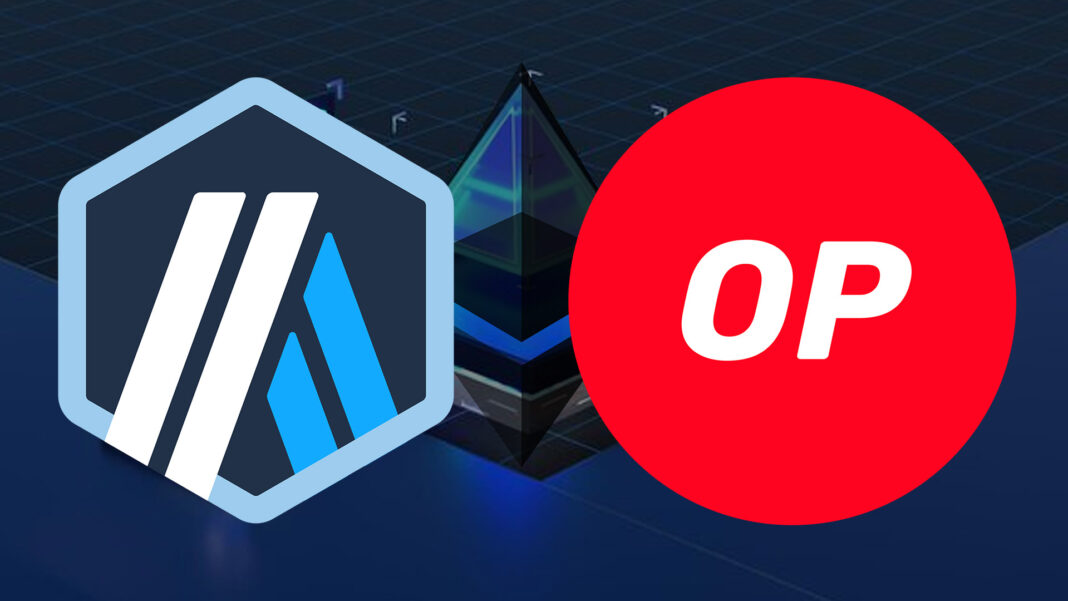- Optimist is a Layer-2 scaling solution that runs as a separate blockchain built on top of the Ethereum network.
- Arbitrum on the other hand, is a centralized approach that uses single-round fraud proofs (Sequencer) to enable faster transactions.
Arbitrum and Optimism are two of the most prominent Ethereum Layer-2 Rollups that are considered potential solutions to Ethereum scalability. Both solutions aim to reduce network limitations by offering instant transactions, reduced gas fees, and a user-intuitive interface.
Ethereum’s brilliance as one of the leading decentralized networks comes with its own challenges including high gas fees and low throughput putting hurdles in the way of Web3 adoption. Both technologies employ optimistic rollups while they are distinct in nature with their fraud proofs and EVM (Ethereum Virtual Machine).
Technological Comparision
However, both Optimism and Arbitrum inherit optimistic rollup. While Optimism employs optimistic rollups as single-point fraud proofs while Arbitrum employs multi-round fraud proofs. This fraud-proof method difference results in variations in gas fees and speed between different solutions.
Yet, in terms of virtual machine compatibility, Optimism depends on the EVM, which enables developers to easily port their current Ethereum smart contracts. Meanwhile, Arbitrum has its own virtual machine known as Arbitrum Virtual Machine (AVM) that offers greater customization options and flexibility for developers apart from their cost of less compatibility with traditional Ethereum-backed smart contracts.
What are Rollups and Layer-2
Layer-2 is a blockchain solution that’s built on top of the Layer-1. This technology was developed to enhance the capabilities of existing protocol while eliminating the hurdles of underlying Layer-1. Layer-2 is mostly responsible for the improvement of existing L1 capabilities as it provided high throughput value with a minimal transaction fees. It addresses the challenges of existing protocols by implementing potential improvemnt in the mainnet.
Arbitrum uses Optimistic Rollups to enhance Ethereum network scalability to make transaction regardless Layer-1. It’s done by batching the transactions together and their subsequent placement on the mainnet. It ensures that all operations on the blockchain runs according to the rules. Rollups significantly serves as checkpoint in Ethereum Blockchain.
User Experience and Adoption
Currently, Arbitrum is leading over Optimism with several key features such as unique contract deployment, TVL (Total Value Locked), and some major protocols. Arbitrum’s TVL stands at $2.1 billion. On the other hand, Optimism’s total value locked is $0.9 billion.
Recently, Arbitrum has shown a significant lead on optimism regarding performance. It currently has a trading volume of approximately $361 million. Arbitrum eclipsed Optimism rollup as it only has a trading volume of $32.8 million. This showcased Arbitrum’s everlasting impact and strong market presence.
However, Arbitrum has reached an average of 1.4 million daily transactions in the previous months, and significantly outperfromed Optimism that only processes 3,00,000 transactions daily. Arbitrum’s user base is compatratively larger than Optimism as it boasts more than 420 thousand active users, while Optimism only has 43K active users.
Both Layer-2 solutions have faced significant growth in their daily active adresses (DAA) and daily transactions. This shows a huge traction from users and developers who are looking for cost-efficient and faster alternatives to Ethereum’s Layer-1.
Conclusion
Both Optimism and Arbitrum are racing towards being the best preference in terms of enhancing Ethereum’s Layer-1 scalability issue. Both rollups have their pros and cons but cons are not that much significant that one should worry about. As both the platforms are trying to put their significant impact in the crypto market, it’s a bit difficult to predict which one is more suitable than other. The future success of these platforms totally depends on the user adoption and developer engagement.




